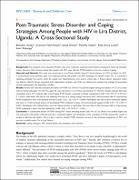| dc.contributor.author | Arebo, Benedict | |
| dc.contributor.author | Ewach, Gracious Faith | |
| dc.contributor.author | Omara, Jacob | |
| dc.contributor.author | Oyella, Pamella | |
| dc.contributor.author | Lucky, Ruth Aciro | |
| dc.contributor.author | Kabunga, Amir | |
| dc.date.accessioned | 2022-05-31T05:58:58Z | |
| dc.date.available | 2022-05-31T05:58:58Z | |
| dc.date.issued | 2022 | |
| dc.identifier.citation | Arebo, B., Ewach, G. F., Omara, J., Oyella, P., Aciro Lucky, R., & Kabunga, A. (2022). Post-Traumatic Stress Disorder and Coping Strategies Among People with HIV in Lira District, Uganda: A Cross-Sectional Study. HIV/AIDS - Research and Palliative Care, Volume 14, 255–264. https://doi.org/10.2147/HIV.S358575 | en_US |
| dc.identifier.uri | doi.org/10.2147/HIV.S358575 | |
| dc.identifier.uri | https://hdl.handle.net/123456789/408 | |
| dc.description.abstract | Background: Post-traumatic stress disorder (PTSD) is the most commonly reported mental health consequence following traumatic
events. However, little is known about how people with HIV cope with the PTSD burden in Lira city, northern Uganda.
Materials and Methods: This study was carried out in Lira District Health Centre IVs from February 10, 2022, to March 10, 2022.
A facility-based cross-sectional study was employed among 390 people with HIV attending Lira Health Centre IVs. A consecutive
sampling technique was used to select the sample size. Questionnaires were used to collect data. A binary logistic regression model
was fitted to identify factors associated with independent variables, and AOR was employed to estimate the strength of association
between independent and dependent variables.
Results: Results show that the estimated prevalence of PTSD was 254 (65.1%) and was higher among the females 191 (75.2%), those
with no formal education 143 (56.3%), aged 40 years and above 121 (47.6%), and married 127 (50.0%). Results indicate that male
respondents had a 51% reduced odds of developing PTSD burden compared to female respondents (AOR: 0.49; 95% CI: 0.30–0.81;
P = 0.005). Individuals who did not use planning activities as a coping strategy had more than 2-fold increased odds of experiencing
PTSD compared to those who planned activities (AOR: 2.43; 1.26–4.70; P = 0.008). Participants who did not have emotional support
had close to 3-fold increased chances of developing PTSD compared to those who had emotional support (AOR: 2.94; 1.74–4.98; P ≤
0.001). Participants who indicated they were not taking recourse to spirituality had more than 4-fold increased odds of experiencing
PTSD compared to those who had spirituality (AOR: 4.40; 1.83–10.46; P = 0.001).
Conclusion: A considerable burden of PTSD among HIV clients attending health centre IVs in Lira District was notably higher and
was associated with gender, planning activities, emotional support and spirituality. Early screening of PTSD among HIV clients is
needed to alleviate the burden. There is also a need to include PTSD treatment services in the treatment programme of HIV care
services in health centre IVs in Lira Distric | en_US |
| dc.language.iso | en | en_US |
| dc.publisher | Dovepress | en_US |
| dc.subject | coping strategies | en_US |
| dc.subject | HIV | en_US |
| dc.subject | mental health | en_US |
| dc.subject | post-traumatic stress disorder | en_US |
| dc.title | Post-Traumatic Stress Disorder and Coping Strategies Among People with HIV in Lira District, Uganda: A Cross-Sectional Study | en_US |
| dc.type | Article | en_US |

